Synthesis and Structure of Unsymmetrical Anthracenyl-Isoxazole Antitumor Agents Via the Diastereoselective Bromination of 3-(9′-Anthryl)-Isoxazole Esters
Abstract
:1. Introduction
2. Materials and Methods
2.1. Materials: Chemistry
2.1.1. General Procedure for The Bromination Reactions
2.1.2. Ethyl 5-Methyl-3-[(1r,2s,3s,4s)-1,2,3,4-Tetrabromo-10-Chloro-1,2,3,4,4a,9a-Hexahydroanthracen-9-Yl]-1,2-Oxazole-4-Carboxylate, 3 (MC221)
2.1.3. General Procedure for The Re-Aromatization Reactions
2.1.4. Ethyl 3-(3,10-dibromoanthracen-9-yl)-5-methyl-1,2-oxazole-4-carboxylate, 4, (MC219)
2.1.5. Ethyl 3-(3-bromo-10-chloroathracen-9-yl)-5-methyl-1,2-oxazole-4-carboxylate
2.2. Methods: Diffractometry
3. Results and Discussion
4. Discussion
5. Conclusions
Supplementary Materials
Author Contributions
Funding
Data Availability Statement
Acknowledgments
Conflicts of Interest
References
- Neidle, S. Quadruplex Nucleic Acids as Targets for Medicinal Chemistry; Annual Reports in Medicinal Chemistry; Elsevier: Amsterdam, The Netherlands, 2020; Volume 54. [Google Scholar]
- Balasubramanian, S.; Hurley, L.H.; Neidle, S. Targeting G-quadruplexes in gene promoters: A novel anticancer strategy? Nature 2011, 10, 261. [Google Scholar] [CrossRef]
- Neidle, S. Therapeutic Applications of Quadruplex Nucleic Acids; Academic Press: Cambridge, MA, USA, 2012. [Google Scholar]
- Dervan, P.B. Molecular Recognition of DNA by Small Molecules. Bioorg. Med. Chem. 2001, 9, 2215–2235. [Google Scholar] [CrossRef]
- Verner, E.J.; Oliver, B.J.; Schlicksupp, L.; Natale, N.R. The Use of Phosphonitrilic Dichloride Cyclic Trimer in Oligopeptide Synthesis. Synthesis of Isoxazolyl-Prodrugs of Netropsin and Distamycin. Heterocycles 1990, 31, 327–339. [Google Scholar] [CrossRef]
- Weaver, M.J.; Stump, S.; Campbell, M.J.; Backos, D.S.; Li, C.; Reigan, P.; Adams, E.; Beall, H.D.; Natale, N.R. 10-N-Heterocylic Aryl-Isoxazole-amides (AIMs) have robust anti-tumor activity against breast and brain cancer cell lines and useful fluorescence properties. Bioorg. Med. Chem. 2020, 28, 115781. [Google Scholar] [CrossRef]
- Duncan, N.S.; Rider, K.C.; Backos, D.S.; Li, C.; Reigan, P.; Stump, S.; Gajewski, M.P.; Beall, H.D.; Natale, N.R. 10-Alkoxy-anthracenyl-isoxazole analogs have sub-micromolar activity against Glioblastoma multiforme. Bioorg. Med. Chem. 2022, 69, 116911. [Google Scholar] [CrossRef]
- Toenjes, S.T.; Gustafson, J.L. Atropisomerisim in medicinal chemistry: Challenges and opportunities. Future Med. Chem. 2018, 10, 409–422. [Google Scholar] [CrossRef]
- Dai, J.; Carver, M.; Hurley, L.H.; Yang, D. Solution Structure of a 2:1 Quindoline-c-MYC G-Quadruplex: Insights into G-Quadruplex-Interactive Small Molecule Drug Design. J. Am. Chem. Soc. 2011, 133, 17673–17680. [Google Scholar] [CrossRef]
- Sevrioukova, I.F.; Poulos, T.L. Structure and mechanism of the complex between cytochrome P4503A4 and ritonavir. Proc. Natl. Acad. Sci. USA 2010, 107, 18422–18427. [Google Scholar] [CrossRef]
- Rider, K.; Burkhart, D.; Li, C.; McKenzie, A.R.; Nelson, J.K.; Natale, N.R. Preparation of chiral isoxazole carbinols via catalytic asymmetric Corey-Bakshi-Shibata reduction. Arkivoc 2010, viii, 97–107. [Google Scholar] [CrossRef]
- Rydberg, P.; Gloriam, D.E.; Zaretzki, J.; Breneman, C.; Olsen, L. SMARTCyp: A 2D Method for Prediction of Cytochrome P450-Mediated Drug Metabolism. Med. Chem. Lett. 2010, 1, 96–100. [Google Scholar] [CrossRef]
- Zanger, U.M.; Schwab, M. Cytochrome P450 enzymes in drug metabolism: Regulation of gene expression, enzyme activities, and impact of genetic variation. Pharmacol. Ther. 2013, 138, 103–141. [Google Scholar] [CrossRef]
- Martin, P.; Oliver, S.; Kennedy, S.J.; Partridge, E.; Hutchison, M.; Clarke, D.; Giles, P. Pharmacokinetics of vandetanib: Three phase I studies in healthy subjects. Clin. Ther. 2012, 34, 221–237. [Google Scholar] [CrossRef]
- Watson, D.A.; Su, M.; Teverovskiy, G.; Zhang, Y.; García-Fortanet, J.; Kinzel, T.; Buchwald, S.L. Formation of ArF from LPdAr(F): Catalytic Conversion of Aryl Triflates to Aryl Fluorides. Science 2009, 325, 1661–1664. [Google Scholar] [CrossRef]
- Liang, T.; Neumann, C.; Ritter, T. Introduction of Fluorine and Fluorine-Containing Functional Groups. Angew. Chem. Int. Ed. 2013, 52, 8214–8264. [Google Scholar] [CrossRef]
- Han, X.; Twamley, B.; Natale, N.R. Preparation of 3-(10′-Halo-9′-anthracenyl)-5-methyl isoxazolecarboxylic Esters. J. Heterocycl. Chem. 2003, 40, 539–545. [Google Scholar] [CrossRef]
- Mirzaei, Y.R.; Weaver, M.J.; Steiger, S.A.; Kearns, A.K.; Gajewski, M.P.; Rider, K.C.; Beall, H.D.; Natale, N.R. Improved synthesis of 3-aryl isoxazoles containing fused aromatic rings. Tetrahedron 2012, 68, 10360–10364. [Google Scholar] [CrossRef]
- Cakmak, O.; Aydogan, L.; Berkil, K.; Gulcin, I.; Buyukgungor, O. Highly brominated anthracenes as precursors for the convenient synthesis of 2,9,10-trisubstituted anthracene derivatives. Beilstein J. Org. Chem. 2008, 4, 50. [Google Scholar] [CrossRef]
- Cakmak, O.; Erenler, R.; Tutar, A.; Celik, N. Synthesis of New Anthracene Derivatives. J. Org. Chem. 2006, 71, 1795–1801. [Google Scholar] [CrossRef]
- Bruker. APEX2; Bruker AXS Inc.: Madison, WI, USA, 2012. [Google Scholar]
- Bruker. SAINT; Bruker AXS Inc.: Madison, WI, USA, 2016. [Google Scholar]
- Sheldrick, G.M. SHELXT—Integrated space-group and crystal-structure determination. Acta Cryst. 2015, A71, 3–8. [Google Scholar] [CrossRef]
- Sheldrick, G.M. Crystal structure refinement with SHELXL. Acta Cryst. 2015, C71, 3–8. [Google Scholar]
- Dolomanov, O.V.; Bourhis, L.J.; Gildea, R.J.; Howard, J.A.K.; Puschmann, H. OLEX2: A complete structure solution, refinement and analysis program. J. Appl. Cryst. 2009, 42, 339–341. [Google Scholar] [CrossRef]
- Sheldrick, G.M. SADABS: Area Detector Absorption Correction; University of Göttingen: Göttingen, Germany, 2001. [Google Scholar]
- Bruker. APEX3; Bruker AXS Inc.: Madison, WI, USA, 2016. [Google Scholar]
- Sheldrick, G.M. A short history of SHELX. Acta Cryst. 2008, A64, 112–122. [Google Scholar] [CrossRef] [PubMed]
- Grundamann, C.; Dean, J.M. Nitrile Oxides. V. Stable Aromatic Nitrile Oxides. J. Org. Chem. 1965, 30, 2809–2812. [Google Scholar] [CrossRef]
- Bode, J.W.; Hachisu, Y.; Matsuura, T.; Suzuki, K. Facile construction and divergent transformation of polycyclic isoxazoles: Direct access to polyketide architectures. Org. Lett. 2003, 5, 391–394. [Google Scholar] [PubMed]
- Bode, J.W.; Hachisu, Y.; Matsuura, T.; Suzuki, K. Amine-promoted cyclocondensation of highly substituted aromatic nitrile oxides with diketones. Tetrahedron Lett. 2003, 44, 3555–3558. [Google Scholar] [CrossRef]
- Groundwater, P.W.; Nyerges, M.; Fejes, I.; Hibbs, D.E.; Bendell, D.; Anderson, R.J.; McKillop, A.; Sharif, T.; Zhang, W. Preparation and reactivity of some stable nitrile oxides and Nitrones. Arkivoc 2000, v, 684–697. [Google Scholar] [CrossRef]
- Dhami, J.K.; Idzorek, K.M.; Johnson, R.B.; Van Auken, K.S.; Ojala, W.H. Intramolecular geometry and intermolecular interactions of the CNO group of crystalline benzonitrile oxides: A comparison with phenyl cyanates, phenyl isocyanates, and phenyl azides. CrystEngComm 2019, 21, 908–916. [Google Scholar] [CrossRef]
- Donald, K.J.; Pham, N.; Ravichandran, P. Sigma Hole Potentials as Tools: Quantifying and Partitioning Substituent Effects. J. Phys. Chem. A 2023, 127, 10147–10158. [Google Scholar] [CrossRef]
- Slebocka-Tilk, H.; Ball, R.G.; Brown, R.S. The question of reversible formation of bromonium ions during the course of electrophilic bromination of olefins. 2. The crystal and molecular structure of the bromonium ion of adamantylideneademantane. J. Am. Chem. Soc. 1985, 107, 4504–4508. [Google Scholar] [CrossRef]
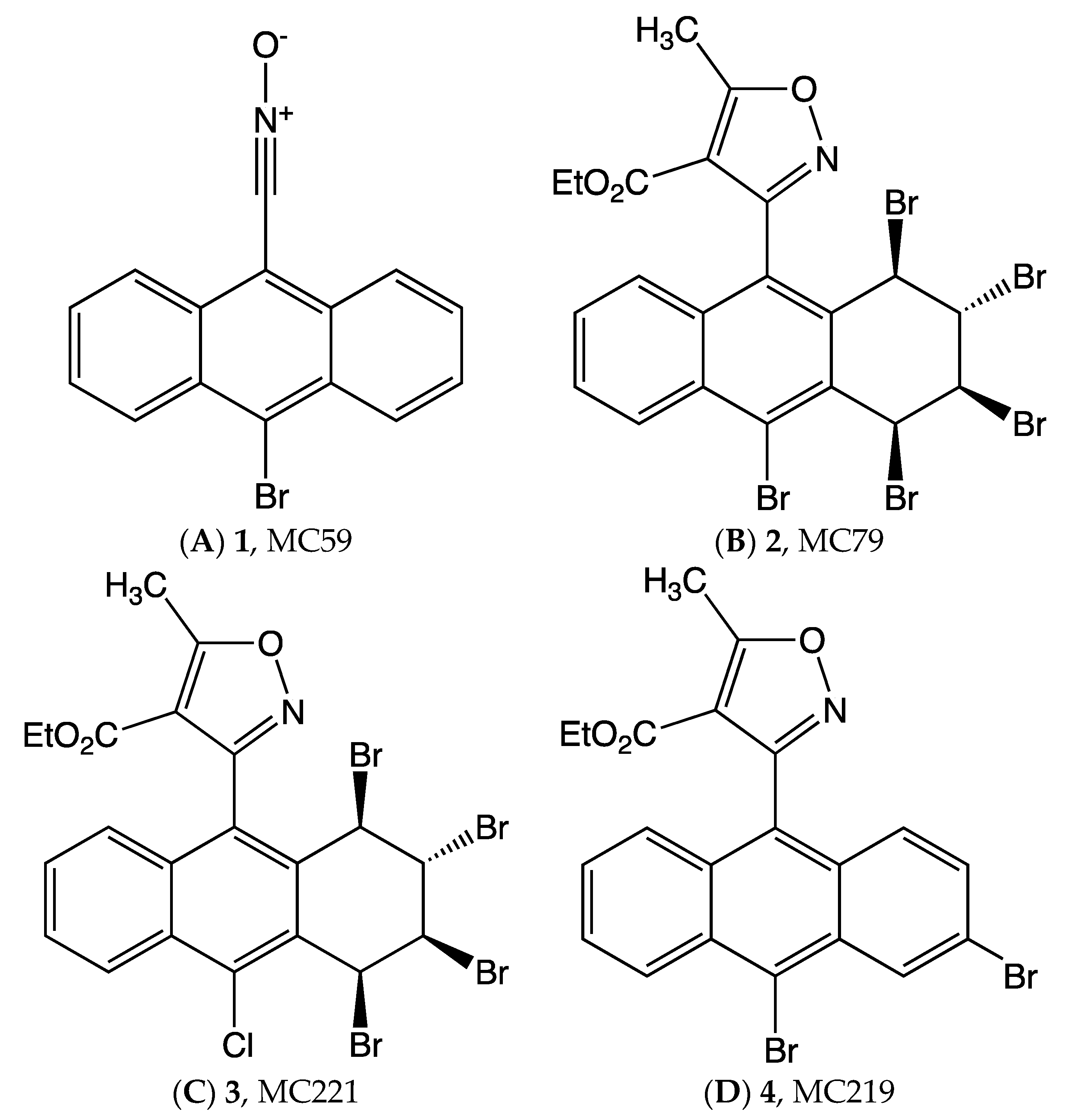
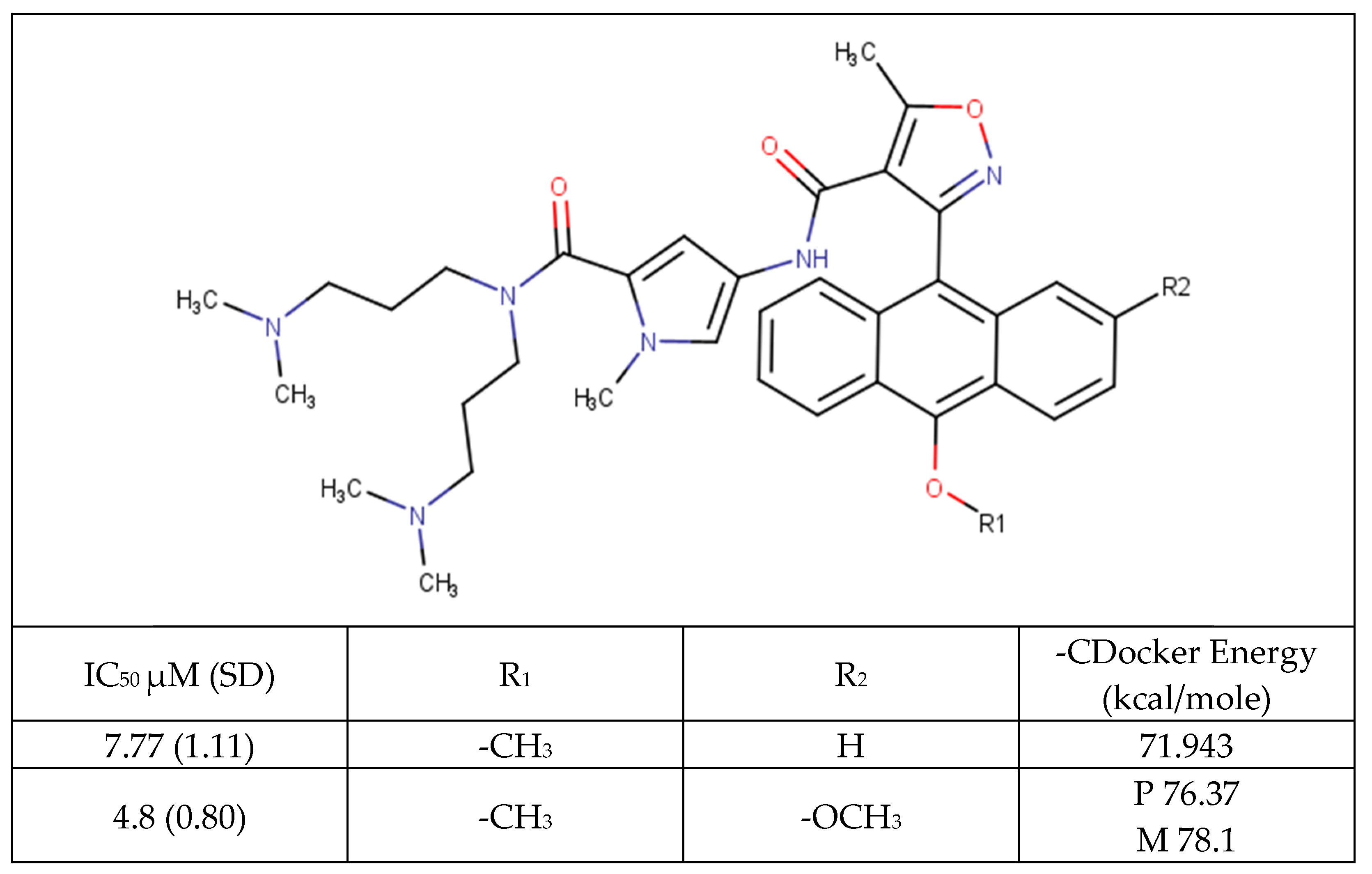



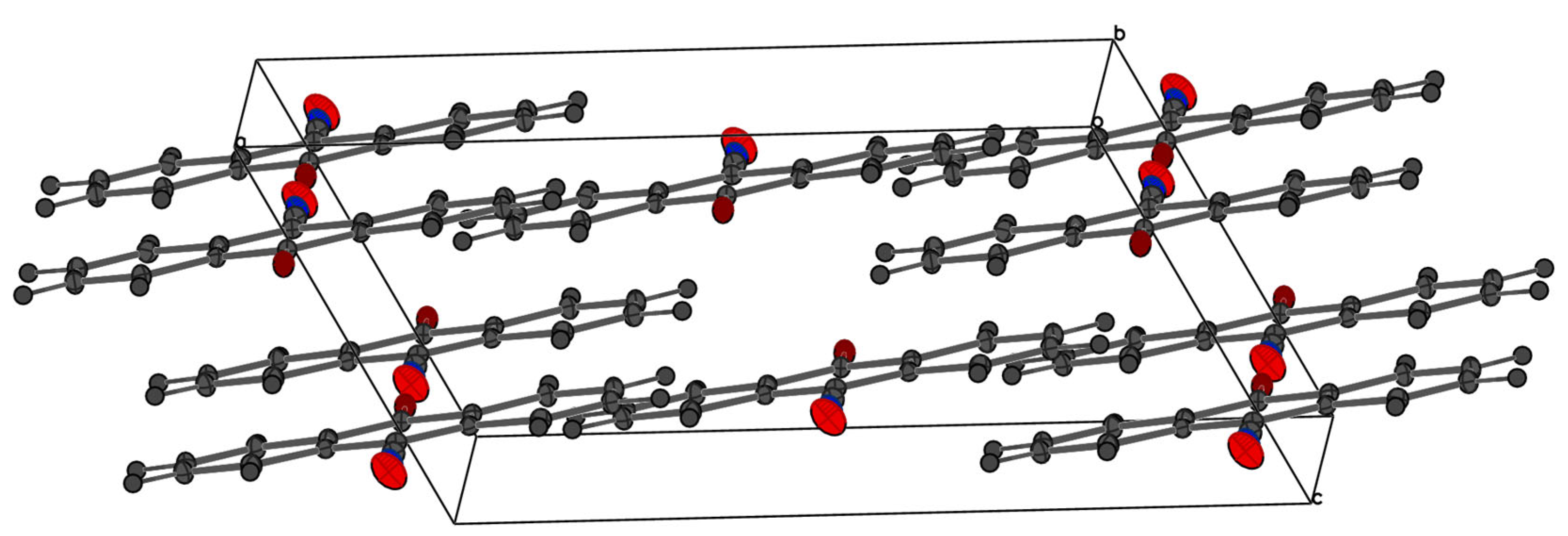

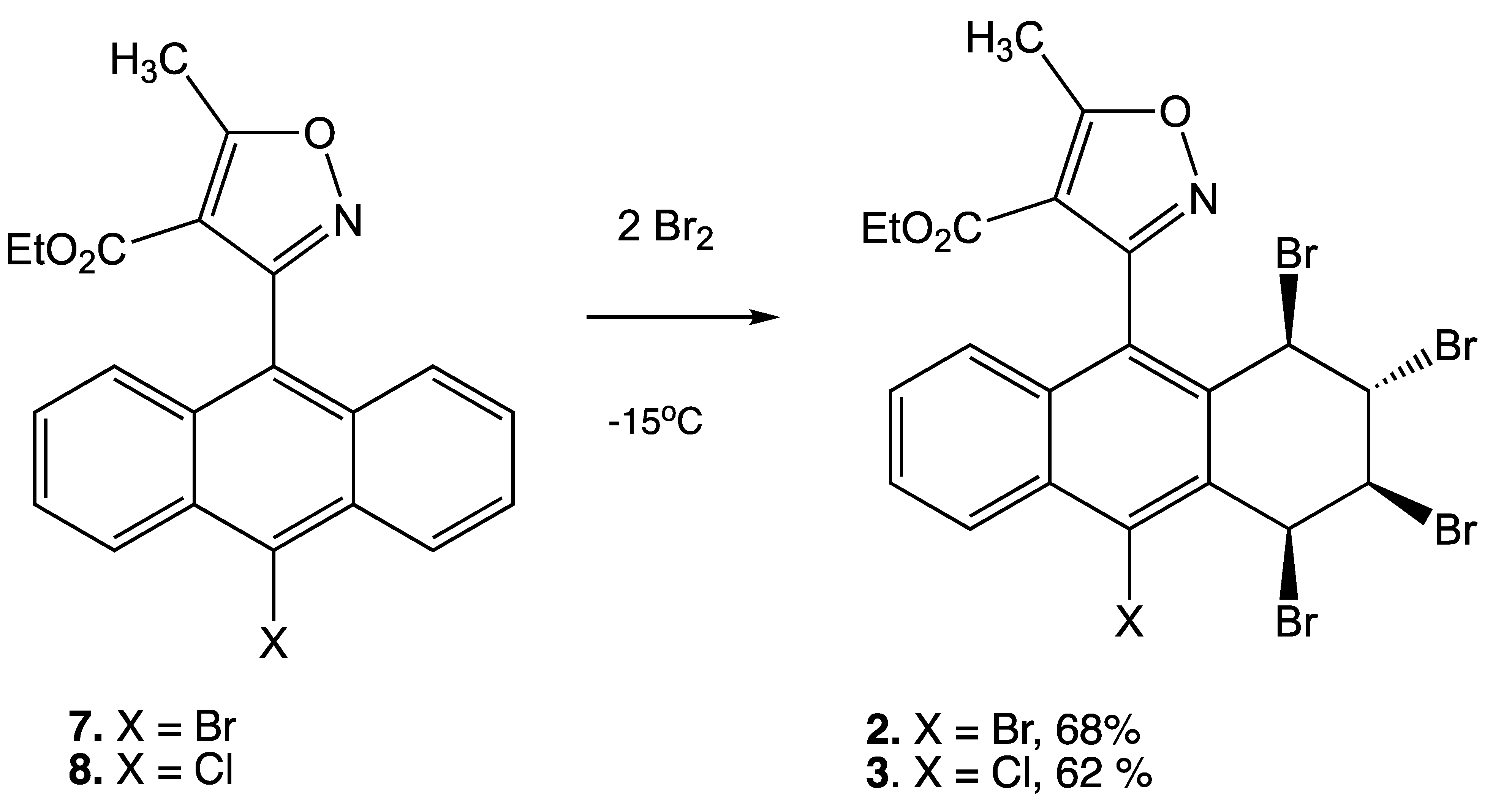
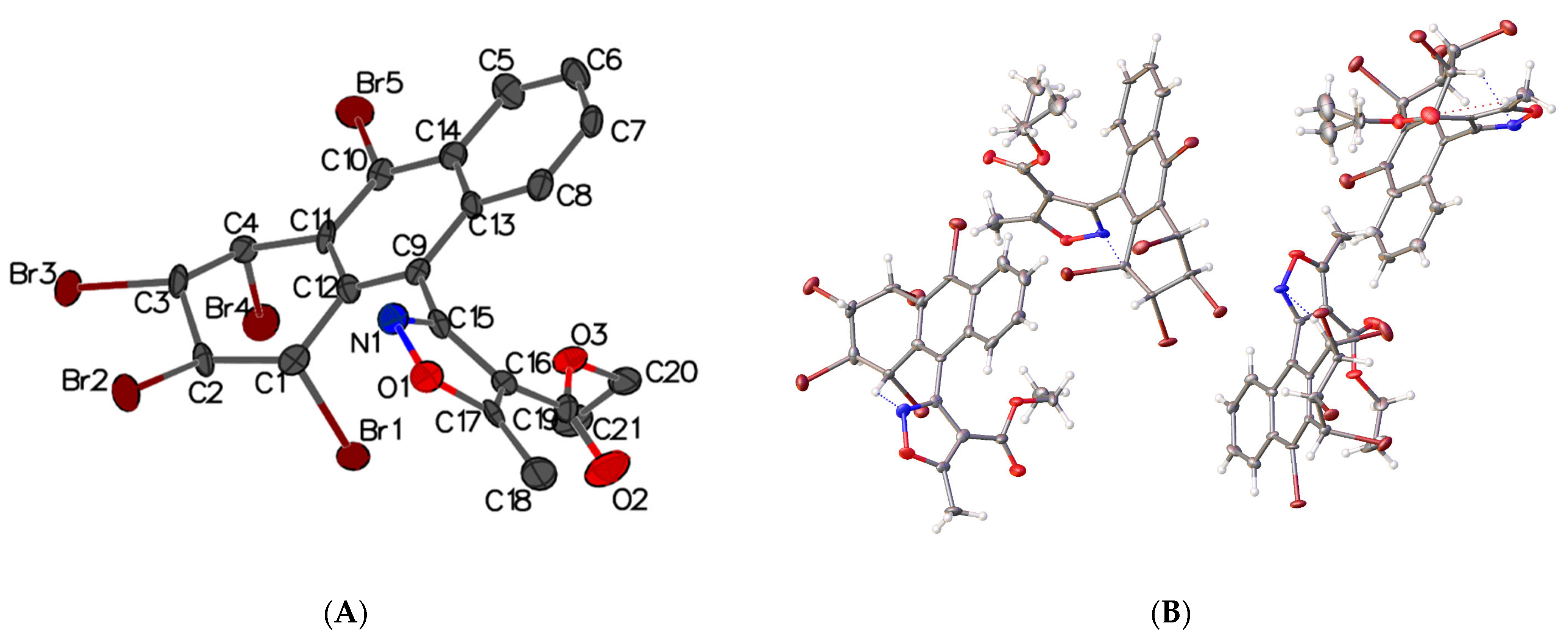
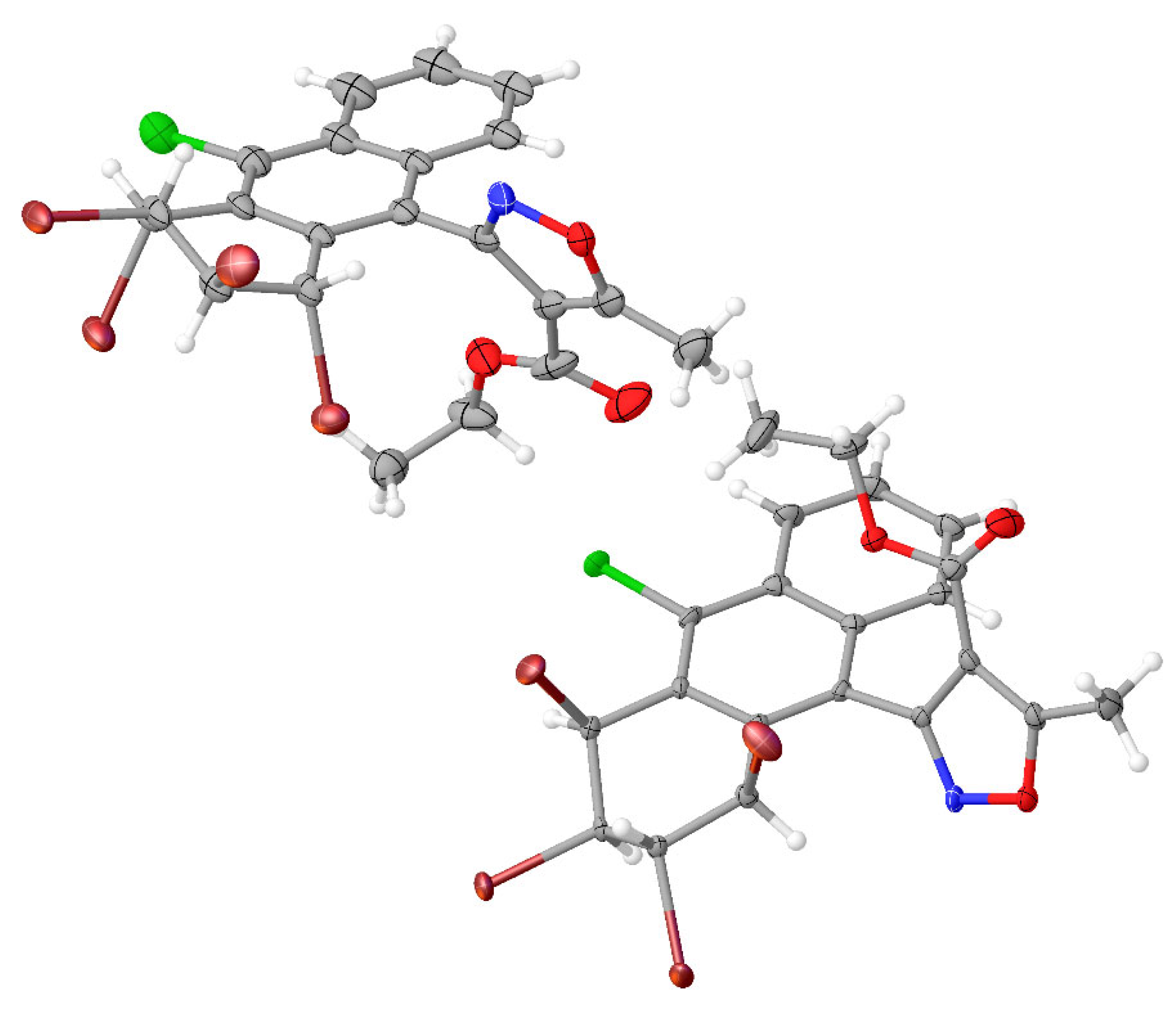


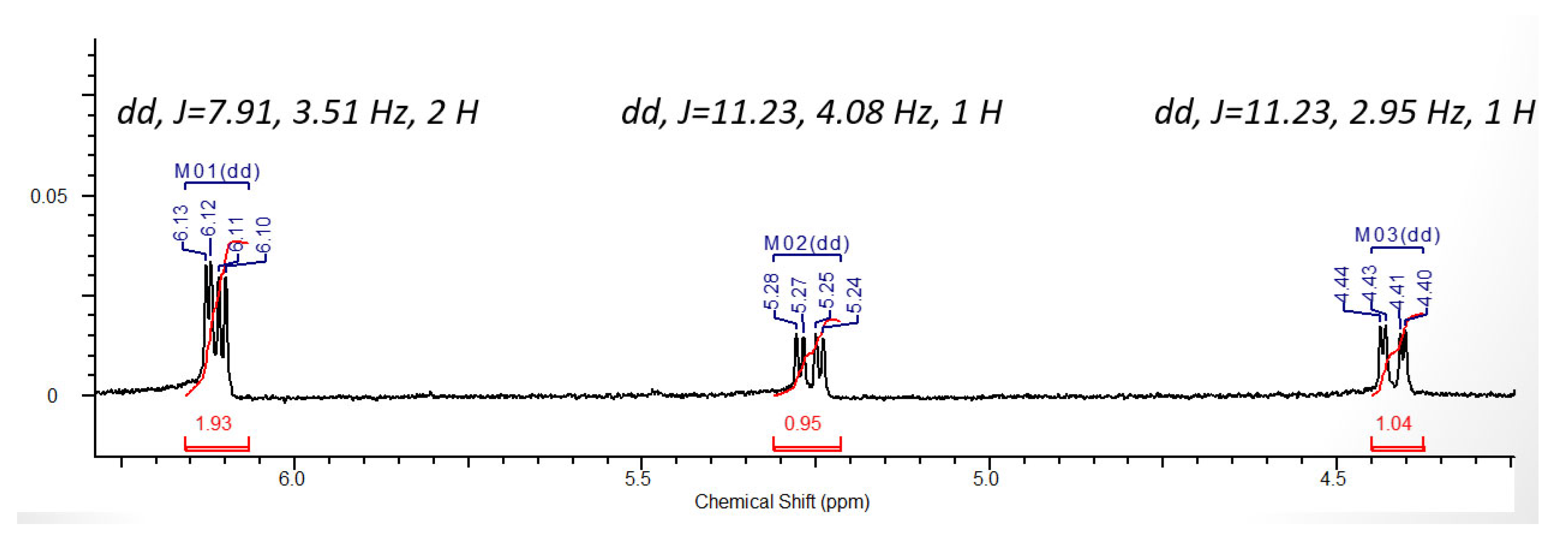
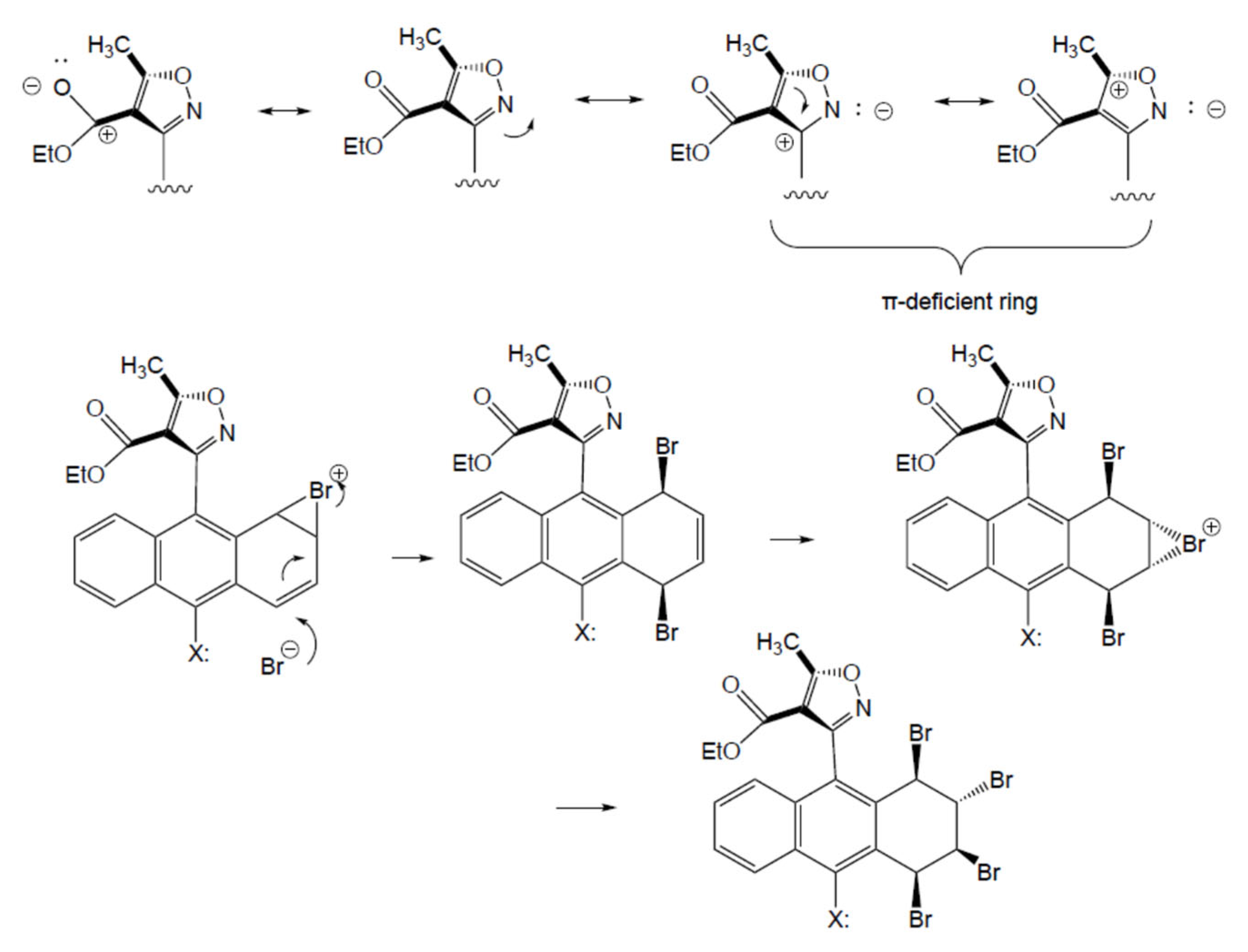
| Compound | 1, Br-Nitrile Oxide (MC59) | 2, Penta-Br (MC79) | 3, TetraBr,10-Cl (MC221) | 4, Di-Br (MC219) |
|---|---|---|---|---|
| Crystal Data | ||||
| Empirical formula | C15H8BrNO | C21H16Br5NO3 | C21H16Br4ClNO3 | C21H15Br2NO3 |
| Formula weight | 298.13 | 729.90 | 685.44 | 489.16 |
| Space group | I12/c1 | P21/n | P21/c | P-1 |
| a/Å | 12.7115 (7) | 18.8346 (6) | 23.9057 (8) | 8.2647 (5) |
| b/Å | 11.5513 (5) | 10.1670 (3) | 10.1752 (4) | 10.6403 (6) |
| c/Å | 7.3873 (3) | 48.1071 (16) | 18.6641 (7) | 11.9185 (7) |
| α/° | 90 | 114.342 (2) | ||
| β/° | 92.121 (2) | 96.431 (2) | 95.2636 (14) | 99.388 (2) |
| γ/° | 90 | 98.989 (2) | ||
| Volume/Å3 | 1083.97 (9) | 9154.1 (5) | 4520.8 (3) | 912.55 (9) |
| Z | 4 | 16 | 8 | 2 |
| Dx mg/m3 | 1.827 | 2.118 | 2.014 | 1.780 |
| μ/mm1 | 3.78 | 8.80 | 7.264 | 4.464 |
| F(000) | 592 | 5568 | 2640.0 | 484 |
| Crystal appearance | Needle, dark yellow | Prism | Monoclinic | |
| Crystal size/mm3 | 0.43 × 0.12 × 0.09 | 0.31 × 0.29 × 0.21 | 0.2 × 0.1 × 0.05 | 0.2 × 0.15 × 0.05 |
| Data Collection | ||||
| Radiation (λ) | MoKα 0.71073 | MoKα (λ = 0.71073) | MoKα (λ = 0.71073) | MoKα (λ = 0.71073) |
| Θ/° | 2.4–30.5° | 2.5–27.2° | 5.804–55.164 | 5.856–55.046 |
| Index ranges | −18 ≤ h ≤ 18 −13 ≤ k ≤ 16 −9 ≤ l ≤ 10 | h = −25→23 k = −13→13 l = −64→64 | −31 ≤ h ≤ 31 −13 ≤ k ≤ 13 −24 ≤ l ≤ 24 | −10 ≤ h ≤ 10 −13 ≤ k ≤ 13 −15 ≤ l ≤ 15 |
| Measured reflections | 6567 | 140,298 | 207,255 | 46,594 |
| Independent reflections | 1666 | 22,760 | 10,423 | 4198 |
| Reflections with I > 2σ(I) | 1639 | 14,809 | ||
| Refinement | ||||
| Parameters | 101 | 1093 | ||
| Goodness-of-fit on F2 | 1.14 | 1.14 | 1.087 | 1.073 |
| R[F2 > 2σ(F2)] | 0.018 | 0.070 | 0.0403 | 0.03 |
| wR(F2) | 0.051 | 0.137 | 0.0880 | |
| Largest diff. peak/hole/e Å−3 | 0.63/−0.24 | 2.19/−1.39 | 2.83/−0.93 | 2.41/−0.54 |
| Calculated Features | ||||
| C(3) aryl-isoxazole dihedral angle (°) | NA | A 110.4 (3) B 105.1 (3) C 65.4 (3) D 67.6 (3) | A 64.10B 67.26 | 76.18 |
Disclaimer/Publisher’s Note: The statements, opinions and data contained in all publications are solely those of the individual author(s) and contributor(s) and not of MDPI and/or the editor(s). MDPI and/or the editor(s) disclaim responsibility for any injury to people or property resulting from any ideas, methods, instructions or products referred to in the content. |
© 2024 by the authors. Licensee MDPI, Basel, Switzerland. This article is an open access article distributed under the terms and conditions of the Creative Commons Attribution (CC BY) license (https://creativecommons.org/licenses/by/4.0/).
Share and Cite
Campbell, M.J.; Decato, D.A.; Li, C.; Weaver, M.J.; Natale, N.R. Synthesis and Structure of Unsymmetrical Anthracenyl-Isoxazole Antitumor Agents Via the Diastereoselective Bromination of 3-(9′-Anthryl)-Isoxazole Esters. Crystals 2024, 14, 256. https://doi.org/10.3390/cryst14030256
Campbell MJ, Decato DA, Li C, Weaver MJ, Natale NR. Synthesis and Structure of Unsymmetrical Anthracenyl-Isoxazole Antitumor Agents Via the Diastereoselective Bromination of 3-(9′-Anthryl)-Isoxazole Esters. Crystals. 2024; 14(3):256. https://doi.org/10.3390/cryst14030256
Chicago/Turabian StyleCampbell, Michael J., Daniel A. Decato, Chun Li, Matthew J. Weaver, and Nicholas R. Natale. 2024. "Synthesis and Structure of Unsymmetrical Anthracenyl-Isoxazole Antitumor Agents Via the Diastereoselective Bromination of 3-(9′-Anthryl)-Isoxazole Esters" Crystals 14, no. 3: 256. https://doi.org/10.3390/cryst14030256





